Unit4Earthquake教案设计
Unit 4 Earthquakes教案

教案Unit 4 Earthquakes(Reading )Background information:Studends:40 Junior high school studends,Grade 1Lesson duration:45 minsI. Teaching ObjectivesBy the end of this lesson, students should be able to1.master the following useful new words and phrases:well,pip,burst,event,dirt,suffer,extreme,injure,destroy,brick,dam,shock,rescue,trap,disaster,bury,mine,shel ter,as if,at an end,dig out,in ruin etc.2.know the basic knowledge about Earthquake.3.develop their reading ability.4.know damages earthquake bring about and the ways to reduce losses of anearthquake.5.be aware of terrible disasters ,know how to protect oneself and help others inearthquakesII. Teaching Important/ Difficult PointsTeaching important points:1.Know the basic knowledge about Earthquake2.Master some useful new words and expressions.Teaching difficult points:1.. The usages of some words and expressions.2. Understand the passage better and develop students reading skill.III. Teaching Methods: task-based language teaching and communicativeIV. Teaching Aids: PPT,computer,blackboard, testbook,V. Teaching ProcedureStep 1 Greetings and Warming-up(4 mins)1.Theacher and students greeting each other.2.Show the pictures of typhoon,flood,hurricane,volcano and earthquake and ask question:Have you ever experienced any natural disasters? Look at the pictures, can you name all the disasters?3.Show some earthquake’s picture s and ask: Have you ever experienced anearthquake? Can you describe how terrible an earthquake is? How could you protect yourself and help others in earthquakes?Step 2 Lead-in ( 2 mins)1.Show the pictures of Tangshan and San Francisco let students discribewhat they see in the picture.What will happen if there has been a bigearthquake in these two cities?2.And ask question: can we avoid or at least reduce the loss caused byearthquakes? Can we foretell earthquakes?Step 3 Pre-reading ( 10 mins)1.Let students look pictures of P25.2.Try to answer the two questions.3.Show the new words and phrases and their meanings.Step 4 Practice( Reading ) (15mins)1.Fast reading and answer the questions.W hy the earth didn’t slee p for a night? What happened? What does the passage mainly talk about?2.Work in group.Exchange your understanding of the passage with group members and work together to find the main idea of each part.Main idea of each part:Part 1 (para.1):Strange things were happening before the earthquake.Part 2 (para.2-3): The disaster happened and caused a lot of loss.Part 3 (para.4): All hope was not lost.3.Careful reading.Read carefully and try to get more information about each part.Read the passage and translate it and explane the usages of the useful new words and phrases and some difficult sentences.Step 5 Post-reading ( 10 mins)1.Read the passage carefully and compelet the task of part 1 on P27.2.Read the passage again and make a timeline(P27).Time EventFor three days ------------------------------At about 3:00 am on july 28,1976 -------------------------------At 3:42 -------------------------------Later that afternoon --------------------------------3.Discuss again. How could you protect yourself and help others in earthquakes? Step 6 Summary and Homework ( 4 mins)1.Summary: Several days before July 28, 1976, many strange things happened inTangshan. They were signs for the earthquake. At 3:42 am that day, the earth began to shake, which destroyed the city. Later that afternoon, another big earthquake struck Tangshan. More people were killed or injured and more buildings fell down. Soldiers were called in to help the rescue workers. Teams were organized to dig out the trapped and bury the dead.2.Homework:1.Finish the “learning about language” part on page 28.2.Explain in their ow n words what the writer means by the title “A night the earthdidn’t sleep”.VI. Blackboard PlanOn the top, there is the title of this lesson. On the left, it lists some important disasters. On the right, there are some useful words and expressions.VII. Reflection: (课后手写,)。
Unit 4Earthquakes教案

Unit 4 Earthquakes教案教学目标【知识目标】Get the students to learn the following useful new words and expressions in this passageGet the students to know basic knowledge about natural disasters.【能力目标】Develop the students reading ability and let them learn different reading skills.Train the students’ ability to collect useful information from the Internet by themselves.【情感目标】Get the students know damages earthquakes bring about and the ways to reduce losses of earthquakes.Get the students to know how to protect oneself and help others in earthquakes. Get the students to be aware of terrible disasters, meanwhile get them to face it, treat it in a proper way, and never get discouraged.教学重难点【教学重点】Get the students to learn about Tangshan Earthquake.Get the students to learn different reading skills.【教学难点】Develop the students’ reading ability.【考点同步解读】一、重点短语1. right away 立刻,马上(= at once = in no time)2. asleep 睡着的;熟睡地(fall asleep 入睡) sleep 睡;睡眠sleepy 犯困的3. it seems that/ as if …看来好像…;似乎4. in ruins 成为废墟5. the number of …的数量(谓语动词用单数) a number of 大量(谓语动词用复数)6. rescue workers 营救人员Come to one’s rescue 营救某人7. be trapped 被困8. how long 多长时间 how often 多久,指平率how soon 还要多久(用于将来时当中,用in+时间段回答)9. hundreds of thousands of 成千上万的10. dig out 挖出11. shake----泛指“动摇,震动”,常指左右、上下动摇,也可以指人“震惊,颤抖”quake---- 指较强烈的震动,如地震例: The building quaked on its foundation Tremble---- 指人由于寒冷、恐惧、不安等引起的身体的抖动或声音的颤抖Shiver---- 多指寒冷引起的颤抖、哆嗦12. rise (rose—risen)---- vi, 上升;升起,无被动语态;give rise to 引起Raise(raised—raised)---- vt, 举起;筹集;养育Arise ( arose—arisen)----vt, 出现(常指问题或现象)13. injure---- 常指因意外事故造成的损伤,也可以指感情上名誉上的伤害harm---- 泛指“伤害,损害”,既可以指有生命的,也可以指无生命的hurt---- 既可以指肉体上的伤害,也可以指精神上的伤害wound---- 一般指枪伤、刀伤等在战场上受的伤例:The bullet wounded him in the arm.14. be prepared for …= make preparations for…为…做准备15. in one’s honor 向…表示敬意;为纪念 Be/ feel honored to do …做…感到很荣幸16. make /give/ deliver a speech 发言opening speech 开幕词17. give/ provide shelter to …向…提供庇护所seek shelter from…躲避18. happen to + n./ pron. 遭遇,发生happen to do sth. 偶然;碰巧happen ----指偶然发生take place----指事先计划好的事情发生二、语法----定语从句1. 关系代词that的用法关系代词that在定语从句中既能指人,也能指物;既能做主语,也能做宾语2. 关系代词which的用法关系代词which在定语从句中只能指物,但既可以做宾语也能作主语3. 关系代词who,whom的用法关系代词who,whom 只能指人,在定语从句中分别作主语和宾语4. 关系代词whose在的用法关系代词whose为关系代词who的所有格形式,其先行词既可以是人也可以是物,whose和它所修饰的名词在定语从句中既可以做主语也可以做宾语。
人教版高中英语必修第一册 《Unit 4:Earthquakes》教案

人教版高中英语必修第一册 《Unit 4:Earthquakes》教案一、教学目标1.知识目标o学生能够掌握与地震相关的重点词汇和短语,如 “earthquake, ruin, destroy, rescue, shock” 等。
o学生能够理解并运用描述地震现象、危害和救援的句型和表达方式。
2.技能目标o学生能够听懂有关地震的简单对话和新闻报道,获取关键信息。
o学生能够阅读并理解关于地震的文章,分析文章结构和主旨。
o学生能够用英语简单讲述地震的相关知识和个人应对地震的措施。
o学生能够写一篇关于地震预防或救援的短文,表达自己的观点和建议。
3.情感目标o培养学生对自然灾害的认识和防范意识。
o激发学生的同情心和社会责任感,关注地震受灾地区和人群。
二、教学重难点1.教学重点o重点词汇和短语的记忆与运用。
o对课文中地震相关内容的理解和语言表达的学习。
o培养学生用英语描述地震和表达应对措施的能力。
2.教学难点o如何帮助学生理解地震的复杂科学原理和巨大危害,并能用英语进行准确描述。
o引导学生在写作中清晰、有条理地阐述地震预防或救援的观点和建议。
三、教学方法1.直观演示法:通过图片、视频等展示地震的场景和数据。
2.问题引导法:以问题为导向,引导学生思考和探究。
3.讨论交流法:组织学生讨论地震相关话题,促进学生之间的思想交流。
四、教学过程(一)导入(5 分钟)1.播放一段地震的视频片段,展示地震的破坏力。
2.提问学生:What do you see in the video? How do you feel about earthquakes?(二)词汇学习(10 分钟)1.呈现本单元的重点词汇和短语,结合地震的情景进行讲解。
2.通过词汇练习,如填空、选择等,巩固学生对词汇的理解和掌握。
(三)阅读前准备(5 分钟)1.让学生观察课文标题和图片,预测文章的主要内容。
2.提出一些引导性问题,如:What might the article talk about earthquakes?(四)课文阅读(15 分钟)1.学生快速阅读课文,概括文章的主旨。
Unit 4 Earthquakes教案设计
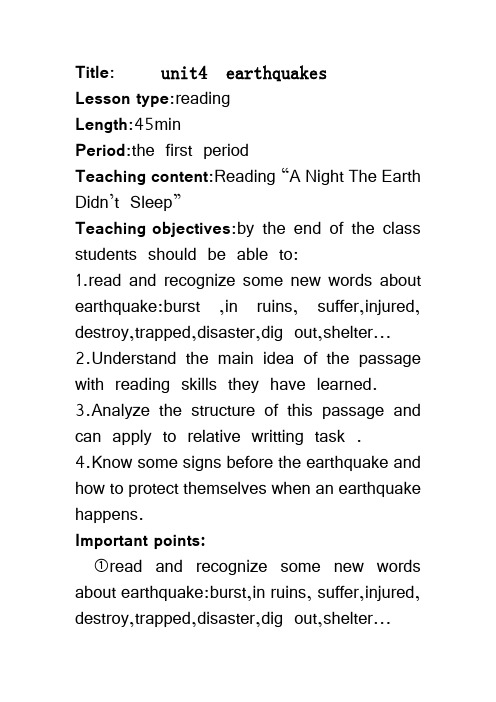
Title: unit4 earthquakesLesson type:readingLength:45minPeriod:the first periodTeaching content:Reading “A Night The Earth Didn’t Sleep”Teaching objectives:by the end of the class students should be able to:1.read and recognize some new words about earthquake:burst ,in ruins, suffer,injured, destroy,trapped,disaster,dig out,shelter...2.Understand the main idea of the passage with reading skills they have learned.3.Analyze the structure of this passage and can apply to relative writting task .4.Know some signs before the earthquake and how to protectthemselves when an earthquake happens.Important points:①read and recognize some new words about earthquake:burst,in ruins, suffer,injured,destroy,trapped,disaster,dig out,shelter...②Know some signs before the earthquake and how to protect themselves when an earthquake happens.Difficult points:①Understand the main idea of the passage with reading skills they have learned.②Analyze the structure of this passage and can apply to relative writting task .Teaching methods:Direct Method, Graphic MethodTeaching aids:PPT,chalks and blackboard,Teaching procedure:Step1:Pre-reading:1.Show some pictures about natural disasters,such as:flood,drought,hurricane,torn ado,mudflow,tsunami,volcano eruption,earthquake,let them guess the names.2.T shows Ss the map of Tangshan City to asks them what they had happened in this city .3.T asks Ss “What do you think will happen before an earthquake?”and let them discuss freely.Step 2:while-reading1 .T asks Ss to skim the whole passage andfinish the form below after skimming.TheTime Events EarthquakeBeforeWhilePost2.T asks Ss to scan the first paragraph and gives them an exercise T or F to finish.①The village wells kept falling .②Chickens and pigs ate a lot more than usually.③Mice ran out of the field to look for places to hide.....3.T gives Ss 3mins to scan the second and the third paragraph, ①Match .Figures EventsAt 3:42 the number of injured and dead peopleOne-third Began to shake 15 seconds of the nation felt it75% , 90% The earthquake last so short②Fill in the blank.Bricks covered the ground like red autumn leaves.Two dams fell and most of the bridges also fell or were not safe for traveling. ...4 Ask Ss to read the last paragraph and answer the following questions.①How were the people helped by the army?*The army organized teams to dig out those who were trapped and to bury the dead.*Miners were rescued from the coal mines.*Shelters were built for survivors whose homes had been destroyed.*Fresh water was taken to the city.Step 3 Post-reading1.T divides Ss into groups to finish exercise in P28-2 as a summary of this passage.(Each group is responsible for a part of it .)2.Check the answers.3.Show them a video(cartoon) about “how to protect themselves when an earthquake happens?”4.Homework:Finish the exercises in page28-1,-3Board design:A Night the Earth Didn't Sleep Para1 Strange things before the earthquakePara2-3 Destruction and damage of earthquakePara4 Rescue after earthquakeTime EventsAt 3:42 began to shake... ...。
Unit4 Earthquakes教案
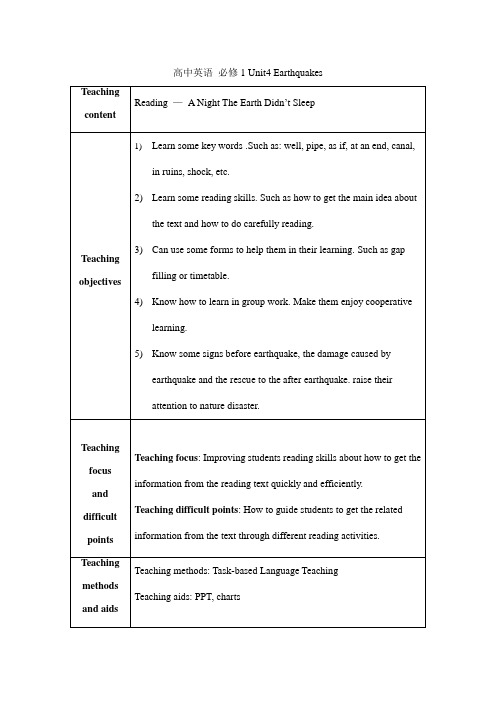
1.Cultivate S’s reading skills about how to get the information from the reading text quickly.
2.make prediction about text’s content.
Teaching difficult points:How to guide students to get the related information from thetext through different reading activities.
Teaching methods and aids
spirits.
Step 4:
Post reading
(10’)
Task1:Understanding the title.(5’)
1.Chose the best answer about the title.
2.Group work:Come up with another title for the text.
2.Choose one paragraph and act out an interview between a reporter and a survivor from theTangshanearthquake.
1.Learn to classify
the words.Make a preparation for
2.Finished P27.Q1(match work)
3.Skimming:find the topic sentence of each paragraph.
4.Think about how to divide the passage into 3 partsandmatchthe main idea of each part.
unit4Earthquake全单元教案
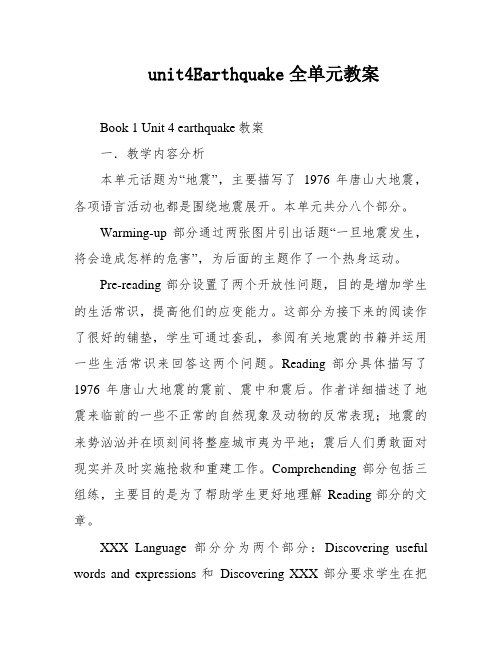
unit4Earthquake全单元教案Book 1 Unit 4 earthquake教案一.教学内容分析本单元话题为“地震”,主要描写了1976年唐山大地震,各项语言活动也都是围绕地震展开。
本单元共分八个部分。
Warming-up部分通过两张图片引出话题“一旦地震发生,将会造成怎样的危害”,为后面的主题作了一个热身运动。
Pre-reading部分设置了两个开放性问题,目的是增加学生的生活常识,提高他们的应变能力。
这部分为接下来的阅读作了很好的铺垫,学生可通过套乱,参阅有关地震的书籍并运用一些生活常识来回答这两个问题。
Reading部分具体描写了1976年唐山大地震的震前、震中和震后。
作者详细描述了地震来临前的一些不正常的自然现象及动物的反常表现;地震的来势汹汹并在顷刻间将整座城市夷为平地;震后人们勇敢面对现实并及时实施抢救和重建工作。
Comprehending部分包括三组练,主要目的是为了帮助学生更好地理解Reading部分的文章。
XXX Language部分分为两个部分:Discovering useful words and expressions和Discovering XXX部分要求学生在把握文章的基础上,掌握重点词汇的词义及时用,这更注重培养学生运用上下文猜测词义的能力。
其次还对一些复杂的数字读法进行了检测。
第二部分则结合文章研究定语从句。
Using Language局部分为Reading,Writing and Speaking;Listening和Writing。
Reading,XXX包孕读一篇约请函,写一份演讲稿和关于一套新唐山邮票的XXX局部报告了一名地动幸存者的故事,并按照听力材料举行正误判别和回覆下列题目,旨在造就学生获得细节的本领,并经由过程听来仿照尺度的语音和腔调。
Writing局部请肄业生报纸写一篇消息报导,进修若何依照尺度的步调举行写作,如挑选得本地题目和构造言语等。
Unit4Earthquake教案设计
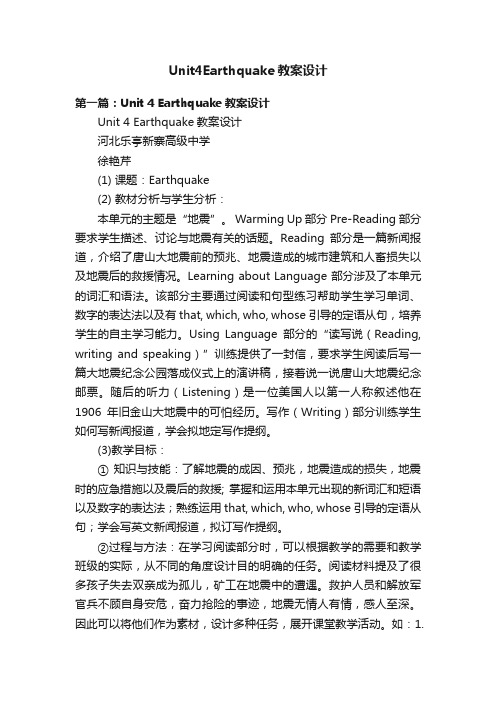
Unit4Earthquake教案设计第一篇:Unit 4 Earthquake教案设计Unit 4 Earthquake教案设计河北乐亭新寨高级中学徐艳芹(1) 课题:Earthquake(2) 教材分析与学生分析:本单元的主题是“地震”。
Warming Up部分Pre-Reading部分要求学生描述、讨论与地震有关的话题。
Reading部分是一篇新闻报道,介绍了唐山大地震前的预兆、地震造成的城市建筑和人畜损失以及地震后的救援情况。
Learning about Language 部分涉及了本单元的词汇和语法。
该部分主要通过阅读和句型练习帮助学生学习单词、数字的表达法以及有that, which, who, whose引导的定语从句,培养学生的自主学习能力。
Using Language部分的“读写说(Reading, writing and speaking)”训练提供了一封信,要求学生阅读后写一篇大地震纪念公园落成仪式上的演讲稿,接着说一说唐山大地震纪念邮票。
随后的听力(Listening)是一位美国人以第一人称叙述他在1906年旧金山大地震中的可怕经历。
写作(Writing)部分训练学生如何写新闻报道,学会拟地定写作提纲。
(3)教学目标:① 知识与技能:了解地震的成因、预兆,地震造成的损失,地震时的应急措施以及震后的救援; 掌握和运用本单元出现的新词汇和短语以及数字的表达法;熟练运用that, which, who, whose引导的定语从句;学会写英文新闻报道,拟订写作提纲。
②过程与方法:在学习阅读部分时,可以根据教学的需要和教学班级的实际,从不同的角度设计目的明确的任务。
阅读材料提及了很多孩子失去双亲成为孤儿,矿工在地震中的遭遇。
救护人员和解放军官兵不顾自身安危,奋力抢险的事迹,地震无情人有情,感人至深。
因此可以将他们作为素材,设计多种任务,展开课堂教学活动。
如:1.组织学生讨论震后孤儿的安置2. 模拟采访被抢救的矿工。
【教案】Unit 4 Earthquakes
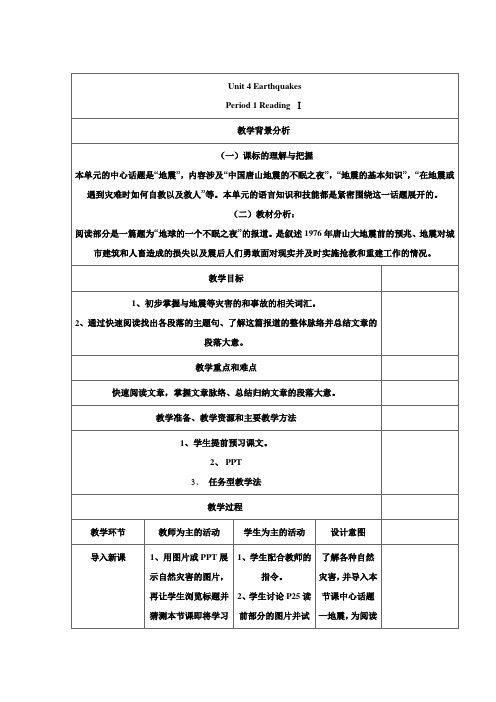
目标引领
展示学习目标:
1、初步掌握与地震等灾害的和事故的相关词汇。
2、通过快速阅读找出各段落的主题句、了解这篇报道的整体脉络并总结文章的段落大意。
学生朗读学习目标,明确这节课学习任务。
使学生明确本节课的学习目标。
活动导学
1、看报道标题并要求学生理解标题。
(二)教材分析:
Learning about Language:Discovering useful words and expressions提供的词汇学习及运用练习。1是要求学生通过理解词语的意义来拼写单词;练习2是要求学生在理解课文后写出与地震相关词语,是联想归纳的词汇练习;练习3要求学生利用课文学到的词语做短文填空;练习4要求学生模仿造句,掌握as if在联系动词的用法,根据学生学情这部分教师可以重新设计较为简单的句子。
Part 3(Para.4) After the earthquake
1、学生在课本上划出各段落主题句,小组讨论并汇报。
2、学生把文章分成三部分并填空。
让学生带着任务去阅读划出主题句有助于学生了解各段落大意及整体文章脉络的了解。
当堂评价
让学生完成《同步练习册》P48环3速读1。
学生完成练习并核对答案。
(二)教材分析:
本节课主要语法项目是定语从句,掌握定语从句的概念,了解先行词,关系代词(that, which, who, whom, whose)的用法及that的一些特殊用法。在Discovering useful structure中设计了三道练习:练习1要求学生找出阅读文章中带有定语从句的句子;练习2要求学生用that, which ,who,或whose填空完成句子、翻译成汉语并作比较;练习3要求学生通过游戏的形式造句并用定语从句拓展这些句子。
- 1、下载文档前请自行甄别文档内容的完整性,平台不提供额外的编辑、内容补充、找答案等附加服务。
- 2、"仅部分预览"的文档,不可在线预览部分如存在完整性等问题,可反馈申请退款(可完整预览的文档不适用该条件!)。
- 3、如文档侵犯您的权益,请联系客服反馈,我们会尽快为您处理(人工客服工作时间:9:00-18:30)。
(5) (6)Unit 4 Earthquake 教案设计河北乐亭新寨高级中学 徐艳芹(1) 课题: Earthquake(2) 教材分析与学生分析 : 本单元的主题是“地震” 。
Warming Up 部分 Pre-Reading 部分要求学生描述、讨论与地 震有关的话题。
Reading 部分是一篇新闻报道,介绍了唐山大地震前的预兆、地震造成的城 市建筑和人畜损失以及地震后的救援情况。
Learning about Language 部分涉及了本单元的词汇和语法。
该部分主要通过阅读和句型练习帮助学生学习单词、数字的表达法以及有that, which, who, whose 引导的定语从句,培养学生的自主学习能力。
Using Language 部分的"读写说( Reading, writing and speaking )”训练提供了一封信,要求学生阅读后写一篇大地震纪 念公园落成仪式上的演讲稿,接着说一说唐山大地震纪念邮票。
随后的听力( 一位美国人以第一人称叙述他在 1906 年旧金山大地震中的可怕经历。
写作( 训练学生如何写新闻报道,学会拟地定写作提纲。
of重点语法项目:由 that, which, who, whose 引导的定语从句 .难点: 1. Teach the students how to enjoy an article2. Teach the students the way to express themselves.3. The usage of the wordsof that, which, who and whose.教学策略 : Student-centered method, asking and answering, explaining and practicing,reading and discussion, speaking and listening, pair work教学煤体设计 :A projector and a tape recorder.Liste nin g )是Writing )部分 (3)教学目标: ① 知识与技能: 了解地震的成因、 预兆,地震造成的损失, 地震时的应急措施以及震后的救援 ; 掌握和运用本单元出现的新词汇和短语以及数字的表达法;熟练运用that,which, who, whose 引导的定语从句;学会写英文新闻报道,拟订写作提纲。
② 过程与方法:在学习阅读部分时,可以根据教学的需要和教学班级的实际,从不 同的角度奋力抢险的事迹, 地震无情人有情,1. 组织2. 模拟采访被抢救的矿工。
3. 写一篇新闻故事, 描述救护人感人至深。
因此可以将他们作为素材,设计多种任务,展开课堂教学活动。
如: 学生讨论震后孤儿的安置 员和军队救灾的感人故事。
③ 情感态度与价值观:中逃生和救生方法的了解。
教学重点和难点: 词汇: shake rise培养日常对自然现象的观察能力和思考能力,对地震等灾难(4) destroy damarmy organize 短语: at an end right awaysmelly pondburst canal steam dirt useless shock quake rescue bury shelter fresh honor prepare dig out a (great) number of ruin injure electricity disaster Europe give outthousands(7) 教学过程:Step I. RevisionCheck the homework with the whole class.Step II. Warming upAsk the students to read the instructions and make sure they know what to do, and then have adiscussion about the two pictures.T: Today, before we begin our reading, I 'd like to ask you a question,What is the biggest s you have heard in your life ”S1: The sound of wind that blew in a winter night when I was very young. It sounded like a ghost who was howling. I was very frightened at that time.S2: The biggest noise was the one that I heard when my neighbor was quarrelling with his wife. Perhaps, they broke their TV set.T: That 's too terrible.S3: The noise when planes take off.S4: The sound of trains.T: Good! I agree that all of them are big sound. But did you once heard the sound that the heaven falls and the earth cracks, in Chinese it is 天崩地裂Ss: No, we have no chance to hear that.T: If there is a sound like this, what is itS5: When someone hears something unexpected and terrible. For example, when one of his loved families dies, he will feel this sound.T: Terrific! You are using a literary way to express the sound.S6: When an earthquake happens.T: Great! I have waited for this answer for a long time. Today we' lllearn something about earthquakes. Ithink most of us have heard of earthquakes. Can you imagine how terrible it is S7: The earth is shaking .All the buildings will fall down.S8: Many people will die. And perhaps many children will lose their parents.T: Yeah, earthquakes are disasters to everybody. Now look at the two pictures of Tangshan and San Francisco. Can you describe what you see in the picturesS1: Tangshan is a beautiful city. It has beautiful gardens, broad roads and some tall buildings.S2: From the picture of San Francisco, I can see that it is a very big city. There are many tall buildings thickly standing on the earth. I think the population of the city is very large.T: Good! What will happen if there has been a big earthquake in these two cities Work in pairs and discuss it. Then I 'll ask so me of you to show your opinion.Step III. Pre-readingThere are two questions in this part. Both are very interesting. The first one can more or less reveal the students 'values; while the second one can enlarge their imagination. Nomatter what their answers are, as long as they have given careful thoughts to the situations, theiranswers should be good.T: Now, let 's look at the pictures. What are the predictions ofe a nrthquakeS1: Before an earthquake animals will become nervous. Cows, pigs, horses and dogs will be upset. And people can see mice running about. If the earthquake happens during winter, people can even see snakes.T: Terrific! Where did you get this knowledgeS1: From geography. I like it.T: good. Sit down please.S2: Madam, I don ' t know the meaning of the picture with two women.T: It doesn 'mt atter. You will know it soon after reading our text. OK. Imagine there is an earthquake now, and your home is shaking, at this moment you have no time to take any other things but one, what will it beS3: I ' ll take all my money. People can ' t live without money.S4: I will take as much water as possible. Because it is said that people can keep alive for nearly 7 days by drinking without any foodS5: In that case, I ' d rather take some apples, so that besides drinking, I can also eat.S6: I will carry my grandma. She is my most loved person in this world. She brought me up. T: What a dutiful child you are! I ' m very glad to hear that. Sit down please! It seems that all of you know what you should do during an earthquake. OK. Let ' s read our text, and see what it tellsus.Step IV. ReadingIn this part, teacher should ask the students to read the passage quickly for the first time to get the general idea of the passage. Ask them to pay attention to the first sentence of each paragraph.This can help them finish exercise3 in Comprehension. It is about the main idea of each paragraph.Then ask them to read the text again carefully to obtain some details. Before reading for the second time, show some questions on the screen, and let the students read the questions first. Thesequestions can guide them to have a good understanding about the text. They can also make preparations for Exs1-2,which are about details.SkimmingT: At first I ' d like to read the text quickly to get the general idea of the article.While reading, you should pay attention to the sentence of each paragraph.T: Have you got the general idea of the textSs: Yes.T: What is itS1: There is no quick answer to this question . Are you suggesting us that the general idea is the mixture of the first sentences of each paragraphT: Sure.S1:OK. That 'esasy. The main idea of the passage is some signs of the earthquake, and what would happen during the quake.T: Good, sit down please. In fact, while we are answering the questions, we have involved the sequence, the functional item for this unit. (Teacher writes the word on the blackboard ) Do you understand themeaning of the wordSs: No.T: Sequence means the order of the events. It can tell us which event happens first, and which happens later. Do you know the sequence that is used in our textS3: Yes. At first, the text tells us something that happened before the quake, then it tells us the things that happened during the quake and at last it tells us the things that happened after the earthquake. T: Quite right! Now please look at the screen, these are the first sentences of each paragraph.Read them and think if they are the main idea of the text. If necessary, you may make some changes to make more exact.Teacher shows the screen and gives a little time to think it over.1. Strange things were happening in the countryside in the northeast Hebei.2. The disaster happened and caused a lot of loss.3. All hope was not lost.Careful readingT: Now, it 'tims e for us to read the text carefully. But before reading, you should read questions first. These questions may help you get some information quickly and easily.Now look at the screen, and read the questions.Show on the screen1. What natural signs of a coming disaster were there2. Can you think of some reasons why these signs weren3. What events probably made the disaster worse4. What situations probably made the disaster worse5. How were the survivors heldStep V. ExtensionShow the questions on the screen.1. From whose point of view are events described How do you know2. What is the mood of this passage How is it created3. Why do you think the writer chooses to express his feelings about the quake ratherthan simply reporting what had happened4. Why is the title A NIGHT THE EARTH DIDN'T SLEEP 5. What does the sentence“ Slowly, the city began to breathe again.Step VI ComprehendingAnswers to Exx1-3. C 2. E2. 1. The walls of the villages wells had cracks in them.3. Brick buildings were destroyed.5. Shelters were put up for those with no homes. 3. 1. Strange things were happening in the countryside in northeast Hebei.. disaster happened and causeda lot of loss. hope was not lost.Step VII HomeworkWrite a composition on how to protect ourselves in an earthquake 课后反思:总体感觉上,本节课上得比较成功,心情愉快。
